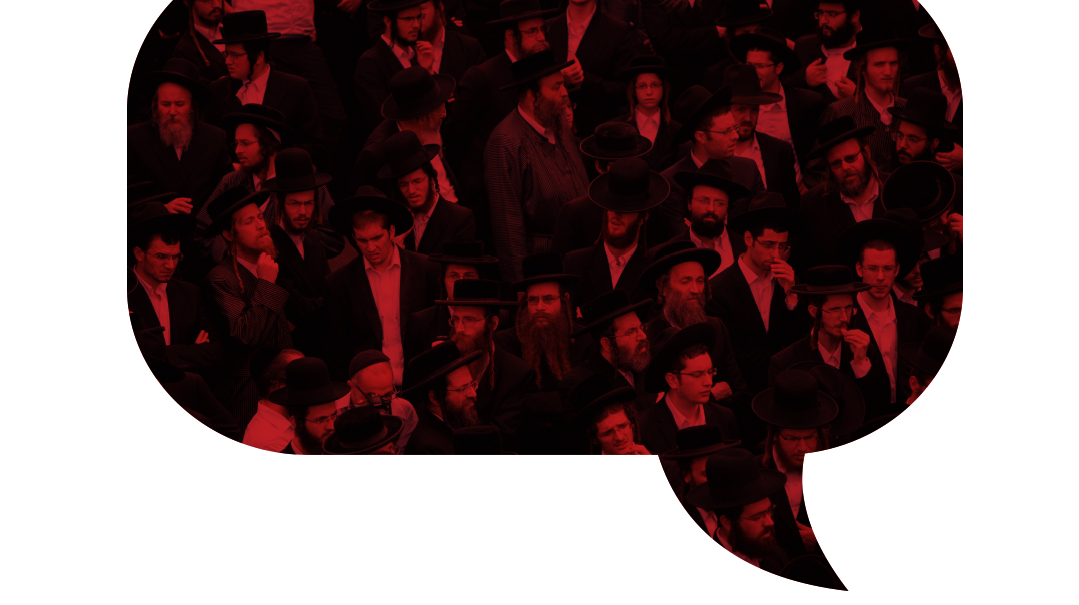Who’s the Kanoi?

Tolerance is in vogue, but does it go both ways?
A week ago, I happened to pick up a distinguished-looking older gentleman walking at the side of the road in White Lake, near Satmar Country. (Yes, that’s how they refer to their bungalow colonies: Satmar Country, Klausenberg Country, Vizhnitz Country — as if these are little regimes with capital cities, flags, and borders you have to cross through, whispering Levi Yitzchok ben Sarah Sasha all the while.)
Some young children near the side of the road were “playing” demonstration, waving anti-Zionist signs and screaming gevald, and I asked my elderly passenger, who clearly remembered the Rebbe, Rav Yoel Teitelbaum, what he thought: Was this the Rebbe’s legacy?
If I imagined that his presence in my car obligated him to engage in discussion with me, he clearly saw things differently. He pulled out a sefer from his shopping bag and started to learn as I drove. Then he lifted the old volume of Mishnayos, Seder Taharos. “This,” he said, “this is what the Rebbe wanted from us.”
Minutes later, I dropped him off at the shul, the seat next to me still simmering with his quiet intensity.
It got me thinking about the impoverished generation in which we live. We are in danger, and the danger is that we are raising children — and adults — who see people as a shitah, and if they don’t understand the ideology, then they wave away the whole group.
Granted, the comments sections on frum websites don’t generally showcase the most sophisticated opinions — but they are opinions just the same. I’ve seen and heard the word “Satmar” used as an adjective and noun to describe general intolerance and rigidity, with little thought given to the underlying ideology. It usually goes something like this:
Satmar? They’re the people who protest in front of the Israeli embassy. I won’t give them a penny.
Really?
Whatsapp messages have brought me no end of shtusim, but within the stream, along with the chassidishe kid singing the national anthem and the Hispanic camp custodian speaking Yiddish, I found a prize: a very clear audio file of Mike Tress giving a speech at the sheva brachos of Rabbi and Mrs. Josh Silbermintz. I listened to it several times, hearing passion and determination and confidence in every word. The Agudah leader emotionally shared a comment from a young child he’d met at a Pirchei group in Brownsville. Mr. Tress had asked the children why they came to Pirchei, and this six-year-old raised his hand and said, “I come to Pirchei because I live like the Shulchan Aruch tells me to.”
The child understood that a party or ideology can only be seen as successful inasmuch as it strengthens and feeds in to the ultimate party, that of Shulchan Aruch Jews.
I am not a Satmar chassid. If I lived in Eretz Yisrael, I would vote and I would certainly not participate in anti-government protests — but that’s irrelevant.
A friend of mine attended a minyan on 26 Av, the yahrtzeit of the Rebbe, where the chazzan, a learned balabos skipped Tachanun. Someone took issue with it. “We’re not Satmar chassidim here,” he called out.
The chazzan turned to him. “True,” he said, “but if not for that man, you wouldn’t be where you are.”
Rav Shlomo Freifeld would describe going to the Satmar Rebbe, entering the room from which such generosity flowed, to request funding for P’eylim, the effort to rescue refugee children from the clutches of state officials who wanted to erase the “galus” from these little survivors and remake them as new Jews. The Satmar Rebbe asked what the volunteers did with the boys they saved, and Reb Shlomo said that the children were sent to Chinuch Atzmai schools, where they could receive a Torah education.
The Satmar Rebbe was frustrated, wondering why they would send these rescued children back to mosdos that received funding from the same enemy government, but even as he spoke, the Rebbe was directing his gabbai to fill out a generous check.
“And I saw,” Rav Shlomo said, “how man can live in several dimensions at the same time.”
It’s been 40 years since the Rebbe’s passing. Do we know how to live in different dimensions?
Today, tolerance and ahavas Yisrael are in vogue; but somehow, they always flow left. If you look at a kanoi through negative eyes because you don’t agree with him, then you too are a kanoi, radiating the intolerance you claim to abhor. Ahavas Yisrael and seeing the good in a Jew go both ways.
If the Lubavitcher Rebbe created an army of soldiers ready to make sure a Jew knows how to say Shema Yisrael, the Satmar Rebbe created an equally dedicated army of soldiers who say the words “a toiveh teen a Yid” like it’s the single greatest goal in life.
The Satmar chassid is doing his shlichus when he pulls over on a rainy night, his own children restless in the back of his minivan, to change a tire for someone he doesn’t know. The meals his wife voluntarily prepares as she stands on her feet for long hours will be delivered to patients across New York hospitals, who — even if they think the cook is “extremist” and “wouldn’t give them a penny” — have no ideological problem enjoying the vegetable soup, schnitzel, and mashed potatoes.
The Torah that has come forth from Satmar — not just the Rebbe’s own sefarim and chiddushei Torah, but those of his talmidim and their talmidim — has illuminated countless batei midrash. The chassidus was among the first to create the model for kvias ittim, the expectation that that a balabos has to learn seriously every day.
The avodah of Satmar — the way the Rebbe took the Shovavim period and invested diamond cutters and electronics wholesalers and melamdim with soaring spiritual goals — showed the rest of the American Torah world that it was still possible.
And the tzedakah…
What is the very worst insult one can give a Satmar chassid? “Call me whatever you want,” a Satmar friend once told me, “ubber reef mir nisht karg, don’t call me cheap!”
A Sephardic askan I know organizes trips from Montreal to various kivrei tzaddikim. One route includes the Satmar tziyun in Monroe and ohel in Queens (also Woodbury Common, but that’s beside the point). “Rabbi Yoel,” he confidently assured me, “is a segulah for parnassah: He asked a lot from his chassidim, but he made sure they could afford it too. They make money and they share it with whoever needs.”
Step back in awe and look at what Satmar has done, what it represents, here in the land of the free. Whether or not you connect to the shitah, contemplate the fact that just as all Jews are a family, all Shulchan Aruch Jews are an army. On the 26th of Av, 40 years after his passing, mourn the general that has fallen.
Originally featured in Mishpacha, Issue 774. Yisroel Besser may be contacted directly at besser@mishpacha.com
Oops! We could not locate your form.








